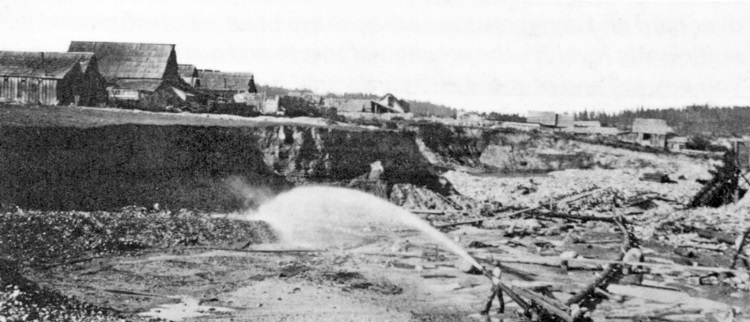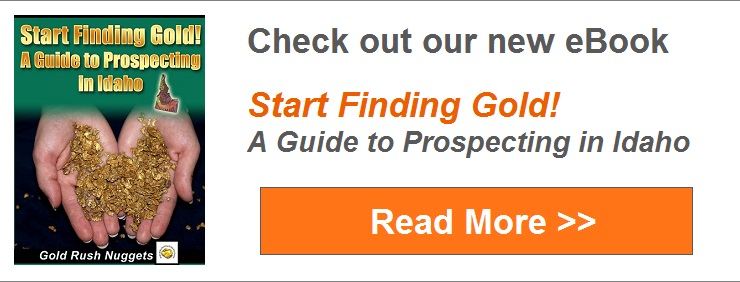
This boom was a major contribution to the development of Idaho into a state. With the civil war at its beginning in the east, in 1862, George Grimes was inspired by a story he heard from the natives of the area. He was told that there was so much gold lying around that one could pick it up by the handfuls.
And so, George, Moses Splawn and some prospectors from Walla Walla, Washington, headed out to discover the real truth of the area. Much to their happiness, they did discover placer deposits 25 miles northeast of Boise in 1862. Unfortunately for George he was killed few days after they located the gold. Rumors have it that he was murdered by a greedy prospector but the most common story is that he was murdered by the natives Americans in the area.
The Rapid Rise of the Boise Basin
This discovery led to one of the major gold rush events to take place in the U.S in the 1860s. According to many of the early reports, the Boise Basin had much more gold than Alaska and some buildings of the mining towns had to be destroyed, so that the areas beneath the buildings could be mined.
Furthermore, several other significant numbers of lodes were located in the mining districts. Boise Basin was an area of 300 square miles that contained several mining districts like the Idaho City, Quartzburg, Placerville and Centerville. The major placers were found at Grimes Creek and Mores Creek along with their tributaries.
The placer deposits were mined first by hand, but later the large hydraulic washers came in and really moved material. The gravels release was run through sluices also came in handy but could only be used when the flow of water was high. Water was always a limiting factor in the Boise Basin, and most of the placer mining could only take place during a few months in the spring and early summer.
By 1863, within eight months of the discovery, Boise Basin boasted a population that was estimated to be anywhere between 25,000-70,000 people, with Idaho City alone having a population 6,000. Out of all the mining districts, it is reported that Idaho City was supposedly the most happening towns during the 1860s.
Idaho City produced about 2,167,500 ounces in gold from 1863 to 1896. Then from 1939 to 1958, the district produced around 129,038 ounces in gold, mostly coming from placer deposits. With about 250 businesses running, Idaho City was a very prosperous area with 2 schools, a newspaper, a library, 3 dozens salons, two dozen law offices and five community theaters. The total production was about 2,300,000 ounces in gold.
Pioneerville, located in the northern region of the Boise Basin has been also an active area for lode mining. It was especially active before 1920. The mines in the district like the Golden age mine produced considerable gold between 1895 and 1920. From 1895 to 1959, the total production of Pioneerville sums up to about 25,000 ounces in gold, proving that gold continued to be found even long after the initial gold rush to the area.
The Quartzburg district, located at the southwest end of the ‘porphyry belt’ crossing the northern part of Boise basin had been another active area in lode mining. It has been reported that about 400,000 ounces in gold have been produced from this district in its early years. The district is known as Quartzburg because it was here where miners turned towards quartz mining.
Also Read: The Placers and Hard Rock Gold in Sumpter, Oregon
And: Gold Mining in Warren, Idaho
A Rich Legacy of Mining in Idaho
These were just some of the notable mining districts in the Boise Basin. Overall, about 6 million ounces in gold was produced by Boise Basin in the two decades after its discovery. Fire struck Quartzburg in 1931 and took out the once prosperous town. The ores quickly ran out in Pioneerville and the district declined quite quickly. Idaho City, once being the largest city in the Northwest was at its peak from 1863-1866. Fire struck Idaho City in 1865, 1867, 1868 and 1871, destroying it and eventually turning it to a ghost town.
While the heyday is long over now, there is still some active mining taking place throughout the Boise Basin today. Tailing piles can be seen for miles along numerous creeks throughout the region, and there is still plenty of gold waiting to be unearthed.
Next: 6 Rivers in Idaho that are Still Loaded with Gold








